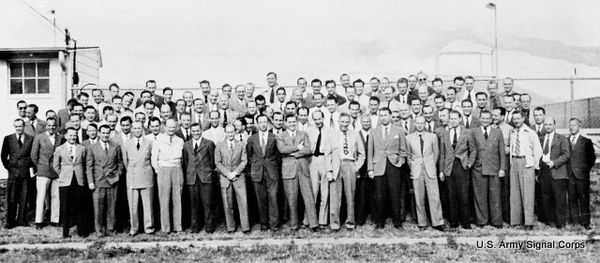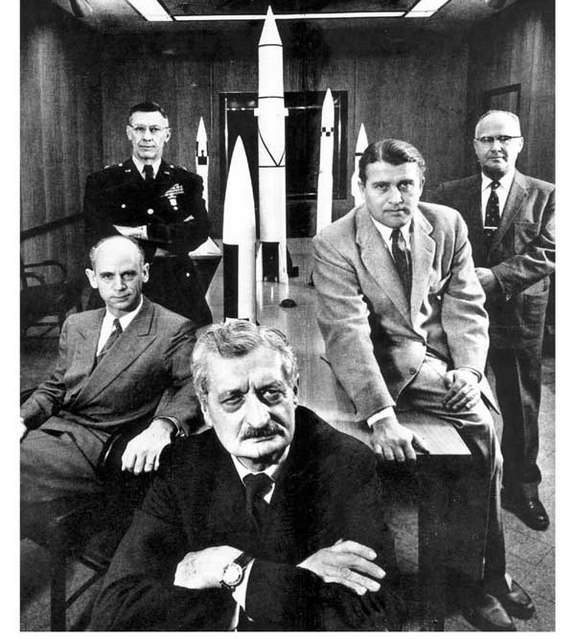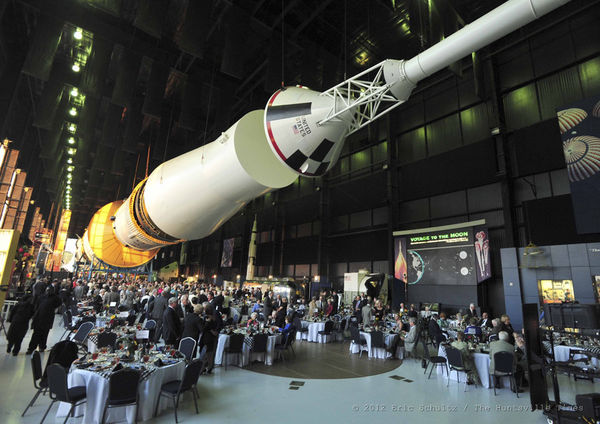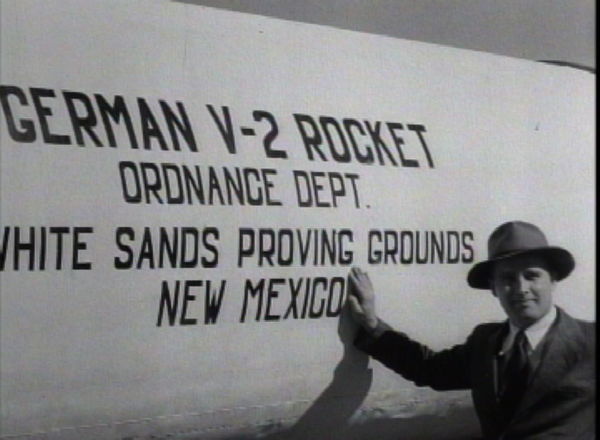How Wernher von Braun shed his Swastika (Part 2 of 2) - Occupied Germany 1945
Oct 7, 2016 02:03:38 #
On June 19, 1945, Major Robert Staver, of the U.S. Army Ordnance, and Lt. Colonel R. L. Williams picked up Wernher von Braun and his department chiefs from their POW enclosure in Austria. After driving them to Munich, they boarded a plane to Nordhausen where they retrieved critical rocket blueprints hidden in an abandoned mine shaft.
The Germans were then evacuated to the American Military Occupation Zone and housed with their families in Landshut -- except von Braun, who was a bachelor and scheduled for interrogation in "Dustbin" (Kransberg Castle).
As of July 19, responsibility for the captured rocketeers was transferred to the Joint Chiefs of Staff in Washington, and administered through the top secret Operation Overcast, which was not authorized to admit Nazis into the United States. A month later, Overcast was morphed into Operation Paperclip, and the "golden door" swung open -- but with a proviso. President Truman banned anybody reported "to have been a member of the Nazi Party and more than a nominal participant in its activities, or an active supporter of Nazi militarism."
That should have prevented the U.S. Army from employing anybody from the V-2 rocket group. But the Paperclip administrators secretly re-wrote the classified dossiers to eliminate unacceptable job descriptions, and "bleached" such interrogation evaluations as "ardent Nazi," "100 percent Nazi, dangerous type," "security risk," and "should be interned as a menace to the security of the Allied Forces," etc.
Anyway, all these men were awarded very critical positions in the U.S. space program, at a time when American aerospace scientists were being laid off. For the military, winning the Cold War was more important than imposing justice, even if it meant defying the President.
In August, 1945, the German V-2 team met in Europe with U.S. Colonel Holger Toftoy, head of the Rocket Branch in the R&D Division of the Army's Ordnance Corps. He offered them one-year contracts, which were accepted by 127 team members, including Wernher von Braun. A month later, von Braun and six others arrived at Fort Strong in Boston Harbor.
After more interrogations -- this time in Virginia at "P.O. Box 1142", a secret prison in Fort Hunt -- they were shipped to Fort Bliss in Texas, and the White Sands Proving Grounds in New Mexico, to set up the V-2 rockets liberated from the Mittelwerk in Thuringen four months earlier.
Wernher von Braun and the others spent the next four years in the heat of the American Southwest, as "War Department Special Employees." Their work involved ballistic missiles, not space rocketry. In March, 1947, von Braun got permission to return to Landshut in Occupied Germany so he could marry his maternal first cousin, 19-year-0ld Maria Luise von Quistorp. He also rescued his father, Baron Magnus von Braun, Sr., who had been expelled from his estate in Silesia when the region was assigned to Poland. However, Texas did not suit the old man, who returned to Germany in 1952. He died in 1972.
Von Braun applied for U.S. citizenship and was sworn in on April 15, 1955, together with other ex-Nazi scientists, on the stage of the Huntsville, Alabama high school. They were now working with space rockets for NASA. He had long since shed his Swastika, but the stigma still hounded him, even though he was now a certified American.
Wernher and Maria had three children in their marriage, two girls and a boy. They grew up in Huntsville and now live in Idaho and the Washington, D.C. area. Wernher died of pancreatic cancer in 1977, age 65. Maria survived and also lives near Washington. In 2012 they joined a large celebration for Wernher von Braun's 100th birthday, held in Huntsville. The city seems to have fond memories of him.
We should keep in mind that Wernher von Braun dedicated his passion and patriotism to the United States for more than thirty years, far longer than his career in Nazi Germany. In 1975, the U.S. government awarded him the prestigious National Medal of Science for his contributions and achievements for our Nation.
The Germans were then evacuated to the American Military Occupation Zone and housed with their families in Landshut -- except von Braun, who was a bachelor and scheduled for interrogation in "Dustbin" (Kransberg Castle).
As of July 19, responsibility for the captured rocketeers was transferred to the Joint Chiefs of Staff in Washington, and administered through the top secret Operation Overcast, which was not authorized to admit Nazis into the United States. A month later, Overcast was morphed into Operation Paperclip, and the "golden door" swung open -- but with a proviso. President Truman banned anybody reported "to have been a member of the Nazi Party and more than a nominal participant in its activities, or an active supporter of Nazi militarism."
That should have prevented the U.S. Army from employing anybody from the V-2 rocket group. But the Paperclip administrators secretly re-wrote the classified dossiers to eliminate unacceptable job descriptions, and "bleached" such interrogation evaluations as "ardent Nazi," "100 percent Nazi, dangerous type," "security risk," and "should be interned as a menace to the security of the Allied Forces," etc.
Anyway, all these men were awarded very critical positions in the U.S. space program, at a time when American aerospace scientists were being laid off. For the military, winning the Cold War was more important than imposing justice, even if it meant defying the President.
In August, 1945, the German V-2 team met in Europe with U.S. Colonel Holger Toftoy, head of the Rocket Branch in the R&D Division of the Army's Ordnance Corps. He offered them one-year contracts, which were accepted by 127 team members, including Wernher von Braun. A month later, von Braun and six others arrived at Fort Strong in Boston Harbor.
After more interrogations -- this time in Virginia at "P.O. Box 1142", a secret prison in Fort Hunt -- they were shipped to Fort Bliss in Texas, and the White Sands Proving Grounds in New Mexico, to set up the V-2 rockets liberated from the Mittelwerk in Thuringen four months earlier.
Wernher von Braun and the others spent the next four years in the heat of the American Southwest, as "War Department Special Employees." Their work involved ballistic missiles, not space rocketry. In March, 1947, von Braun got permission to return to Landshut in Occupied Germany so he could marry his maternal first cousin, 19-year-0ld Maria Luise von Quistorp. He also rescued his father, Baron Magnus von Braun, Sr., who had been expelled from his estate in Silesia when the region was assigned to Poland. However, Texas did not suit the old man, who returned to Germany in 1952. He died in 1972.
Von Braun applied for U.S. citizenship and was sworn in on April 15, 1955, together with other ex-Nazi scientists, on the stage of the Huntsville, Alabama high school. They were now working with space rockets for NASA. He had long since shed his Swastika, but the stigma still hounded him, even though he was now a certified American.
Wernher and Maria had three children in their marriage, two girls and a boy. They grew up in Huntsville and now live in Idaho and the Washington, D.C. area. Wernher died of pancreatic cancer in 1977, age 65. Maria survived and also lives near Washington. In 2012 they joined a large celebration for Wernher von Braun's 100th birthday, held in Huntsville. The city seems to have fond memories of him.
We should keep in mind that Wernher von Braun dedicated his passion and patriotism to the United States for more than thirty years, far longer than his career in Nazi Germany. In 1975, the U.S. government awarded him the prestigious National Medal of Science for his contributions and achievements for our Nation.
104 German rocket scientists at Fort Bliss, Texas - ca. 1947

Hermann Oberth (foreground) was Wernher von Braun's mentor in Germany. Col. Holger Toftoy (left, rear) hired von Braun and the other German scientists.

Celebrating vonBraun's 100th birthday in 2012 (he died at age 65)

Wernher von Braun with "liberated" V-2 rocket in New Mexico

Oct 7, 2016 02:15:10 #
Oct 7, 2016 03:41:25 #
Oct 7, 2016 05:52:14 #
Very interesting. Probably one of the best moves we could have made to advance our rocket science....for better or for worse.....
Oct 7, 2016 06:27:57 #
My father was in the Army/OSS during world war II. He told me they went into Russia to pickup these scientist. They were in a truck that was rigged to blow up but there was defective wiring. Von Braun arm was broken and dad had to set it. There were several ranking German officers in lower rank uniforms.
Dad spoke little of this but after his death several men with deep military backgrounds told me this story.
Dad war into Germany twice in German uniform and into North Africa to check conditions before the invasion.
Dad spoke little of this but after his death several men with deep military backgrounds told me this story.
Dad war into Germany twice in German uniform and into North Africa to check conditions before the invasion.
Oct 7, 2016 06:48:08 #
Oct 8, 2016 05:57:08 #
What strange but useful bedfellows we do make. (A misquote from some guy called Shakespeare.)
Oct 8, 2016 06:51:26 #
Oct 8, 2016 11:00:50 #
That has to be a conspiracy theory right. Just days ago the President, and US leaders say there is no threat bringing military aged so called refugees from jihadi countries. So You trust the US leaders don't you, I mean they would never deceive the American People.
Oct 8, 2016 11:22:59 #
Oct 8, 2016 12:20:19 #
Duggy wrote:
That has to be a conspiracy theory right. Just days ago the President, and US leaders say there is no threat bringing military aged so called refugees from jihadi countries. So You trust the US leaders don't you, I mean they would never deceive the American People.
You make a good point, Duggy. To misquote Winston Churchill "In leading the people, truth is so precious that she should always be attended by a bodyguard of lies."
Oct 8, 2016 12:33:00 #
Richard, many years ago, my dad took me to a lecture presented by Wernher von Braun. Your story of how he got here makes remembrances of that lecture even more special.
--Bob
--Bob
RichardQ wrote:
On June 19, 1945, Major Robert Staver, of the U.S.... (show quote)
Oct 8, 2016 16:12:57 #
Oct 9, 2016 01:46:43 #
Oct 9, 2016 15:53:09 #
If you want to reply, then register here. Registration is free and your account is created instantly, so you can post right away.











